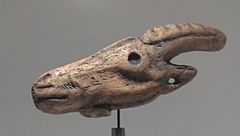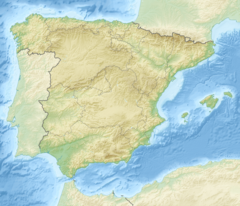Tito Bustillo Cave facts for kids

Carved staghorn found in the cave
|
|
| Location | Ribadesella |
|---|---|
| Region | Asturias, Spain |
| Coordinates | 43°27′38.52″N 5°4′3.72″W / 43.4607000°N 5.0677000°W |
| Official name: Tito Bustillo | |
| Type: | Cultural |
| Criteria: | i, iii |
| Designated: | 1985 (9th session) |
| Part of: | Cave of Altamira and Paleolithic Cave Art of Northern Spain |
| Reference #: | 310-003 |
| Region: | Europe and North America |
| Buffer zone: | 243.38 ha (601.4 acres) |
| Official name: Cueva de Tito Bustillo | |
| Type: | Non-movable |
| Criteria: | Monument |
| Designated: | 12 March 1970 |
| Reference #: | RI-51-0003839 |
The Tito Bustillo Cave is an amazing prehistoric cave in Ribadesella, a small town in Asturias, Spain. Long ago, people called Cro-Magnons lived here, even before 10,000 BC.
Thousands of years ago, the cave's original entrance collapsed. This natural event sealed the cave. It helped keep ancient tools, objects, and incredible wall paintings safe. These amazing discoveries were found in 1968.
Contents
Discovering Ancient Life in the Cave
Scientists know that many people lived in Tito Bustillo Cave. They were part of the Magdalenian culture during the Upper Paleolithic period. This was a very long time ago, in the Stone Age.
The cave is now a World Heritage Site. This means it's a very important place for everyone to protect. It's part of a bigger group of sites called the Cave of Altamira and Paleolithic Cave Art of Northern Spain.
Amazing Cave Paintings
Tito Bustillo Cave has 12 prehistoric paintings. These make it one of the best examples of ancient art in northern Spain. The oldest painting shows human figures. It is about 33,000 years old. Scientists figured this out using a method called radiocarbon dating. This method helps find the age of very old things.
Some scientists think Neanderthals might have made this oldest painting. However, this idea is not yet fully proven.
What the Paintings Show
Many paintings in the cave show animals. You can see horses, deer, and even moose. There is also a painting of a marine animal, which might be a whale. People believe these paintings had a special purpose. They might have been part of rituals to help hunters find more animals.
The oldest painting in the cave is very interesting. It shows a figure that looks like both a male and a female.
Tools and Art from the Past
Besides the paintings, many objects from the Magdalenian period were found. They were kept in perfect condition. The most important finds include harpoons made from bone. There is also a beautifully carved staghorn that looks like a goat's head. These objects tell us a lot about how ancient people lived and what they created.
See also
 In Spanish: Cueva de Tito Bustillo para niños
In Spanish: Cueva de Tito Bustillo para niños




